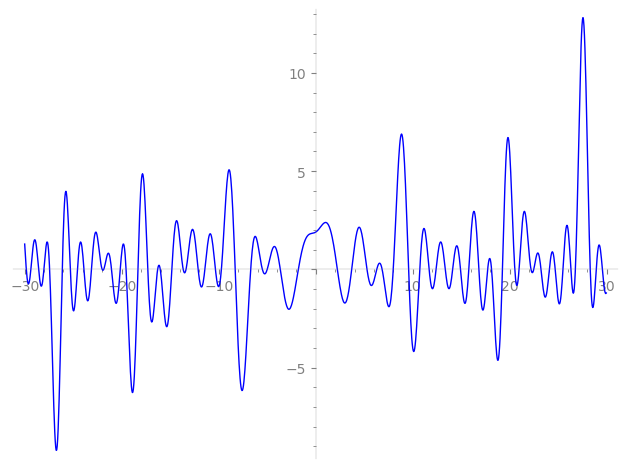| L(s) = 1 | + (1.31 − 0.513i)2-s + (−0.912 + 0.912i)3-s + (1.47 − 1.35i)4-s + (1.46 − 1.68i)5-s + (−0.733 + 1.67i)6-s + (−0.0653 − 0.0653i)7-s + (1.24 − 2.54i)8-s + 1.33i·9-s + (1.06 − 2.97i)10-s − i·11-s + (−0.107 + 2.57i)12-s + (0.473 + 0.473i)13-s + (−0.119 − 0.0524i)14-s + (0.204 + 2.87i)15-s + (0.332 − 3.98i)16-s + (−1.01 + 1.01i)17-s + ⋯ |
| L(s) = 1 | + (0.931 − 0.363i)2-s + (−0.526 + 0.526i)3-s + (0.735 − 0.677i)4-s + (0.655 − 0.755i)5-s + (−0.299 + 0.682i)6-s + (−0.0246 − 0.0246i)7-s + (0.439 − 0.898i)8-s + 0.444i·9-s + (0.335 − 0.941i)10-s − 0.301i·11-s + (−0.0309 + 0.744i)12-s + (0.131 + 0.131i)13-s + (−0.0319 − 0.0140i)14-s + (0.0528 + 0.743i)15-s + (0.0830 − 0.996i)16-s + (−0.245 + 0.245i)17-s + ⋯ |
Λ(s)=(=(220s/2ΓC(s)L(s)(0.865+0.500i)Λ(2−s)
Λ(s)=(=(220s/2ΓC(s+1/2)L(s)(0.865+0.500i)Λ(1−s)
| Degree: |
2 |
| Conductor: |
220
= 22⋅5⋅11
|
| Sign: |
0.865+0.500i
|
| Analytic conductor: |
1.75670 |
| Root analytic conductor: |
1.32540 |
| Motivic weight: |
1 |
| Rational: |
no |
| Arithmetic: |
yes |
| Character: |
χ220(23,⋅)
|
| Primitive: |
yes
|
| Self-dual: |
no
|
| Analytic rank: |
0
|
| Selberg data: |
(2, 220, ( :1/2), 0.865+0.500i)
|
Particular Values
| L(1) |
≈ |
1.83354−0.491808i |
| L(21) |
≈ |
1.83354−0.491808i |
| L(23) |
|
not available |
| L(1) |
|
not available |
L(s)=p∏Fp(p−s)−1 | p | Fp(T) |
|---|
| bad | 2 | 1+(−1.31+0.513i)T |
| 5 | 1+(−1.46+1.68i)T |
| 11 | 1+iT |
| good | 3 | 1+(0.912−0.912i)T−3iT2 |
| 7 | 1+(0.0653+0.0653i)T+7iT2 |
| 13 | 1+(−0.473−0.473i)T+13iT2 |
| 17 | 1+(1.01−1.01i)T−17iT2 |
| 19 | 1−2.65T+19T2 |
| 23 | 1+(5.32−5.32i)T−23iT2 |
| 29 | 1−5.94iT−29T2 |
| 31 | 1−1.44iT−31T2 |
| 37 | 1+(5.27−5.27i)T−37iT2 |
| 41 | 1+5.13T+41T2 |
| 43 | 1+(4.06−4.06i)T−43iT2 |
| 47 | 1+(7.89+7.89i)T+47iT2 |
| 53 | 1+(−2.60−2.60i)T+53iT2 |
| 59 | 1−7.70T+59T2 |
| 61 | 1−7.06T+61T2 |
| 67 | 1+(−5.47−5.47i)T+67iT2 |
| 71 | 1+1.80iT−71T2 |
| 73 | 1+(−5.16−5.16i)T+73iT2 |
| 79 | 1−14.2T+79T2 |
| 83 | 1+(−11.9+11.9i)T−83iT2 |
| 89 | 1+5.69iT−89T2 |
| 97 | 1+(0.398−0.398i)T−97iT2 |
| show more | |
| show less | |
L(s)=p∏ j=1∏2(1−αj,pp−s)−1
Imaginary part of the first few zeros on the critical line
−12.11958497397502665443461383386, −11.42543456784648680343337957978, −10.33819835365175548490084088577, −9.723847458896414653144354802389, −8.303915177972996513214522828321, −6.70404330228481278574375419233, −5.49962230331611239823887521395, −5.00109772773873541451647611080, −3.65296834201862172864947065186, −1.79140148749787274270072734663,
2.22978421346614828705390282665, 3.70621409831943103843164909669, 5.28531815795923366984717247156, 6.29121920684143919758051267333, 6.84482919533330499286492839889, 7.989354990795769072340058121419, 9.572814531805546894399298231278, 10.72596727433304238946470118086, 11.68690842864470167210631757891, 12.40726944964209372888768418275

